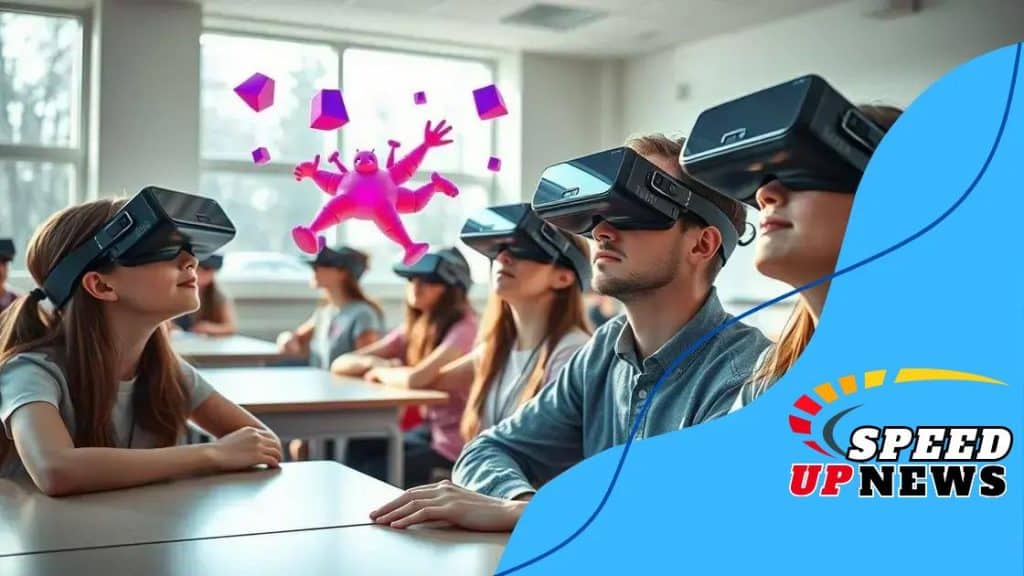How AR is being used for hands-on learning experiences

Augmented reality (AR) enhances hands-on learning experiences by engaging students in interactive environments, improving understanding of complex subjects, and fostering personalized education tailored to individual learning styles.
How AR is being used for hands-on learning experiences is transforming traditional educational methods. Imagine wandering through a historic site without leaving your classroom. Sounds fascinating, right? Let’s dive into this innovative approach.
Understanding augmented reality in education
Understanding augmented reality in education is essential for grasping how innovative teaching methods are transforming classrooms today. By blending digital elements with the real world, AR enhances learning experiences and engages students in significant ways.
What is Augmented Reality?
Augmented Reality, or AR, overlays digital information onto the real world, allowing users to interact with both environments simultaneously. This technology can be as simple as a mobile app that displays 3D models or as complex as immersive educational environments.
How AR Enhances Learning
With AR, students can visualize concepts that are otherwise difficult to grasp. Imagine a biology class where students can explore the human anatomy in 3D! Such interactive elements make lessons more engaging.
- Increased student engagement by making learning fun.
- Improved understanding of complex subjects.
- Enhanced collaboration among students during activities.
- Opportunities for creative expression through interactive projects.
This vibrant interaction fosters a deeper connection to the material being taught. As a result, students are more likely to retain information and apply it in real-world contexts.
Examples of AR in Education
Numerous tools and applications have emerged that utilize augmented reality. For instance, apps like Google Expeditions allow students to take virtual field trips to historical sites or explore the solar system in 3D.
Moreover, AR is not limited to one subject; it can be applied in various fields, such as art, history, science, and math, making it a versatile tool in any educator’s arsenal. Using such platforms, teachers can create immersive learning environments that go beyond the textbook.
The integration of augmented reality into the classroom setting makes learning more dynamic and accessible. Students are more likely to participate and express their ideas when technology supports their learning experiences.
Benefits of AR for hands-on learning
The benefits of AR for hands-on learning are vast and impressive. By introducing this technology into educational settings, teachers can create immersive experiences that engage students in unique ways. This method of learning helps students grasp complex concepts through direct interaction.
Enhanced Engagement
One of the most significant advantages of augmented reality is its ability to boost student engagement. When learners interact with digital elements that overlay real-world scenarios, they are more likely to participate actively in their education.
- Students enjoy learning through interactive tools.
- AR turns passive learning into an engaging experience.
- Increased motivation through gamified educational content.
- Students can explore and experiment in a safe environment.
This increased engagement leads to higher retention rates, encouraging students to explore topics more thoroughly. As they connect with the material on a deeper level, their understanding solidifies.
Real-World Applications
Hands-on learning through AR allows students to apply their knowledge in practical ways. For example, in a science class, students can observe chemical reactions in 3D, giving them a clearer picture of what occurs during experiments. This realistic visualization turns theoretical knowledge into tangible skills that can be applied outside of school.
Moreover, AR can facilitate collaboration among students. Working together on AR projects allows them to learn from each other and build teamwork skills. This collaborative environment enhances social interactions and fosters a sense of community in the classroom.
As students face challenges together, they also develop problem-solving abilities. The instant feedback provided by AR applications helps learners correct mistakes and learn from their experiences effectively.
In summary, using augmented reality for hands-on learning not only makes education exciting but also prepares students for real-world challenges by bridging the gap between theory and practice.
Case studies of AR applications in classrooms

Case studies of AR applications in classrooms reveal how this technology enhances the learning environment. Educators around the world are integrating augmented reality to create interactive experiences that captivate students and enrich their educational journeys.
Successful Implementations
Schools that have adopted AR technology often report positive outcomes. For example, a school district in California used AR to enhance their science curriculum. Students were able to explore the solar system through an app that allowed them to visualize planets and their orbits. This activity not only ignited interest but also helped students retain complex information better.
- Students engaged in virtual field trips to historical landmarks.
- Interactive biology lessons that allow students to explore the human body in 3D.
- Math classes using AR to visualize geometric shapes and solve problems.
- Art classes where students create digital sculptures using AR tools.
An example from a school in Texas showed that students studying anatomy could use AR apps to see 3D models of organs. This hands-on approach made learning about body systems more relatable and enjoyable, leading to greater enthusiasm for the subject.
Student Reactions
Incorporating AR in classrooms has been met with excitement by students. They express joy in using technology that makes learning fun and engaging. Many students reported feeling more involved in lessons and enjoyed collaborating on AR projects with their peers.
The feedback reflects a common trend: students are better at analyzing and understanding topics when they can see them in action. As they interact with the virtual content, their ability to retain knowledge improves significantly.
Moreover, these positive experiences encourage students to think creatively and boost their confidence when tackling new subjects. The engaging nature of AR environments empowers students to ask questions and explore various concepts without fear of making mistakes.
Challenges faced with AR implementation
While the potential of augmented reality (AR) in education is exciting, it also comes with its challenges. Schools face various obstacles when implementing AR technology into their classrooms. Understanding these challenges can help educators and administrators develop effective strategies.
Technical Limitations
One significant hurdle is the technical aspect of AR. Many schools lack the necessary hardware, such as tablets or AR glasses, which can be costly. Additionally, the need for reliable internet connectivity can further complicate the implementation process.
- Inconsistent internet access can hinder AR experiences.
- Insufficient technical support for troubleshooting issues.
- High costs of AR devices and software licenses.
- Lack of familiarity with AR tools among educators.
These technical barriers can limit a school’s ability to integrate AR effectively. To make the most of AR, schools must invest in technology and training for teachers.
Curriculum Integration
Another challenge is integrating AR into existing curricula. Teachers may find it difficult to incorporate AR lessons that align with their teaching goals and standards. They must also ensure that AR complements traditional teaching methods instead of disrupting them.
Furthermore, limited resources and time constraints often make it challenging to develop AR content. Teachers need professional development opportunities to learn how to create and implement AR experiences effectively.
Despite these challenges, the benefits of AR can be transformative for education. Schools can address these obstacles by fostering collaboration among educators and investing in training and resources. By finding innovative solutions, educators can harness the power of augmented reality to enhance learning.
Future trends in augmented reality for education
The future trends in augmented reality (AR) for education look promising and innovative. As technology advances, the potential for enhancing learning experiences continues to grow. Educators are eager to find new ways to engage students using AR tools.
Personalized Learning
One major trend is the shift toward personalized learning experiences. With AR, students can learn at their own pace, exploring topics that interest them deeply. This tailored approach empowers students to take control of their education.
- Adaptive AR content that adjusts to individual learning styles.
- Students select projects based on their interests and abilities.
- Real-time feedback that helps students improve.
- Learning paths that lead to mastery of specific concepts.
As educators utilize personalized AR learning paths, they can cultivate a more engaging and effective educational environment for each student.
Integration with Other Technologies
Another exciting development is the integration of AR with other technologies like virtual reality (VR) and artificial intelligence (AI). By combining these tools, teachers can create even more immersive learning experiences. For instance, a lesson on ancient civilizations could involve students entering a VR world where they can interact with historical figures.
As these technologies converge, students will have access to rich, interactive worlds that offer a deeper understanding of complex subjects. This blended approach allows for creative and dynamic learning experiences that were previously unimaginable.
Furthermore, the use of data analytics in AR applications will provide teachers with insights into student behaviors and performance, helping to fine-tune instruction methods and content delivery.
Collaboration and Remote Learning
Collaboration between students can also be enhanced with augmented reality. Future AR applications may allow students from different locations to work together on projects in real-time. Imagine students collaborating on a science experiment while being miles apart.
This capability will foster teamwork, communication, and problem-solving skills, crucial for success in the modern world. As remote learning continues to grow, AR will play a vital role in maintaining engagement and facilitating group projects.
FAQ – Frequently Asked Questions about Augmented Reality in Education
How can augmented reality improve student engagement?
Augmented reality captivates students by making learning interactive and enjoyable, encouraging them to participate actively in lessons.
What are the technical challenges of implementing AR in schools?
Technical challenges include the high cost of AR devices, the need for reliable internet, and insufficient tech support for educators.
How does AR facilitate personalized learning?
AR allows students to learn at their own pace, providing adaptive content that caters to individual learning styles and interests.
What future trends can we expect in AR for education?
Future trends include increased integration with other technologies, enhanced collaboration features, and a focus on creating immersive learning experiences.





